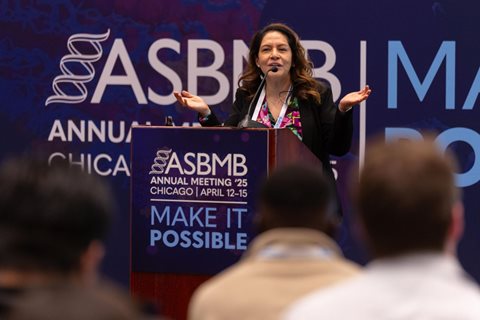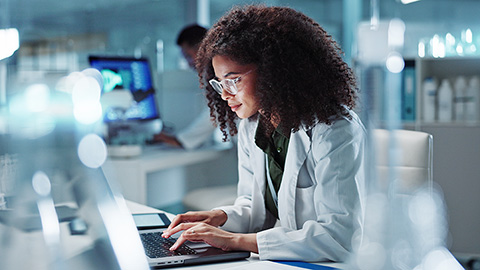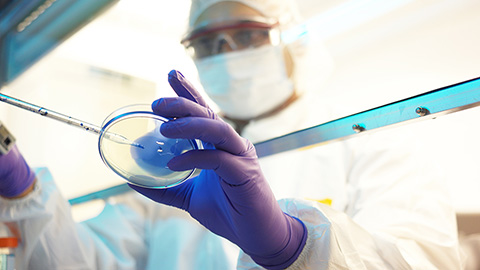‘CoA as the central core’
In August, scientists with various research interests will gather to share their latest research related to CoA and CoA derivatives in Madison, Wisconsin. As its name suggests, the meeting will be centered on one molecule: coenzyme A. The meeting organizers wanted an opportunity for researchers across the globe whose work involves CoA or one of its derivatives to come together to see how all of their research intersects.



Some of the session themes include metabolism, intracellular cross talk, proteostasis, autophagy and technological advances in mass spectrometry.
ASBMB Today talked to the organizers about why they took this molecule-based approach and what they hope attendees will get out of it.
Luigi Puglielli is a professor of medicine at the University of Wisconsin–Madison. His research is focused on the molecular mechanisms of neurodevelopment and neurodegeneration.
James Ntambi is a professor of nutritional sciences also at UW, just a short 20-minute walk from Puglielli’s office. Ntambi’s research examines the biochemistry of diseases such as obesity, diabetes, nonalcoholic fatty liver disease and more.
Suzanne Jackowski is a retired professor of infectious diseases at St. Jude Children's Research Hospital. Her work focused on CoA and neurodegeneration and led to a treatment for pantothenate kinase-associated neurodegeneration.
The interview has been edited for length, clarity and style.
Tell me about the CoA research community.
Puglielli: The CoA research community is not a large one; although CoA and its derivatives are important and play a crucial role in health and disease. There are not that many opportunities where we actually gather and look at CoA as the central core and its biological functions. There have been previous small meetings. I attended one in Marseilles, France, in 2016, organized by the Federation of European Biochemical Societies and another independently organized in Stellenbosch, South Africa, in 2018. Although this molecule is important in biomedical research, everybody tends to go to selective meetings where they target proteostasis, metabolism, etc.
Ntambi: This area of research is fragmented all over the world because CoA is important to so many topics. At most meetings, someone talks about CoA and its derivatives in one session, but I think getting a group together, with people from different disciplines doing work that involves CoA is a good thing.
Jackowski: I attended all of the CoA meetings thus far since 2014, and it's been a global experience. The scientific interest has grown considerably, particularly since CoA has been discovered to be a major factor in several diseases and is a target for development of therapeutics.
Tell me about the focus of this meeting.
Puglielli: The bulk of the meeting will be on CoA and its derivatives and the biochemistry of its biological functions, and then we will branch out to some of the essential pathways downstream of these molecules. CoA allows for cross talk within the cell, between organelles and beyond the cell in the organism.
Jackowski: CoA has many roles in metabolism, and all organisms require CoA. It's almost overwhelming to think about how a CoA deficit can cause dysfunction because the possibilities are numerous. At the upcoming meeting, investigators can sort out some of the links between CoA derivatives and particular processes as we continue to map the network of causality and adaptation.
Why did you choose to highlight metabolism, intracellular cross talk, proteostasis and autophagy, as well as technological advances in mass spectrometry?
Jackowski: CoA is a helper molecule and a nucleotide derivative that is central to biology because it mediates metabolism. CoA has distinct roles in the mitochondria, cytoplasm, nucleus, peroxisomes and endoplasmic reticulum, and yet CoA moves all around the cell via CoA derivatives. The compartments communicate dynamically this way. CoA is involved in everything, everywhere, all at once.
The topics where progress has recently been made in understanding these roles are highlighted in the meeting, including very recent exciting breakthroughs. Reliable, sensitive techniques are required to measure CoA and CoA derivatives; those are fleeting small molecules that recycle efficiently and often.

What are some unique features?
Puglielli: There are not many meetings that focus on CoA. Most meetings look at the “outputs” of this molecule, but not at CoA itself. The idea of this meeting is to be different from all the others in that we go back to the origin, look at these molecules and see how they intersect with all the pathways. The field has been rapidly changing.
Ntambi: The roles of CoA have now been expanded over the last few years. We hope to bring in new ideas from different investigators working in different fields but all involved in CoA.
Jackowski: We have a great deal more information about the specifics of CoA interactions and the impact on biology since the last meeting in 2018. That's been 5 years ago!
What are some of the sessions that excite you?
Puglielli: I am interested in the sessions on metabolic cross talk within the cell. I’ve actually started reading some of the old papers that James (Ntambi) wrote.
Ntambi: I’m also interested in the metabolism of CoA. We now are beginning to see the importance of this molecule in intracellular crosstalk regulation. I’m excited about all the sessions that involve systemic metabolism and communication.
Jackowski: I'm most excited about the session on novel technologies and breakthrough discoveries. The innovative work of several laboratories has uncovered even more new roles for CoA and new forms of regulation of the CoA supply. It looks like different CoA derivatives hang out in different cellular niches and the CoA supply is regulated by multiple mechanisms.
How did you select the speakers?
Puglielli: The three of us tried to come up with speakers that highlight the different areas of CoA research that we hope to bring together. I hope that this meeting can really bring together a considerable amount of diverse people from different areas of biomedical research so that we can see a new perspective.
Any final thoughts to share?
Ntambi: Wisconsin will have excellent weather!
Puglielli: And there will be plenty of cheese!
Enjoy reading ASBMB Today?
Become a member to receive the print edition four times a year and the digital edition monthly.
Learn moreFeatured jobs
from the ASBMB career center
Get the latest from ASBMB Today
Enter your email address, and we’ll send you a weekly email with recent articles, interviews and more.
Latest in Careers
Careers highlights or most popular articles

Building the blueprint to block HIV
Wesley Sundquist will present his work on the HIV capsid and revolutionary drug, Lenacapavir, at the ASBMB Annual Meeting, March 7–10, in Maryland.

Upcoming opportunities
Present your research alongside other outstanding scientists. The #ASBMB26 late-breaking abstract deadline is Jan. 15.

Designing life’s building blocks with AI
Tanja Kortemme, a professor at the University of California, San Francisco, will discuss her research using computational biology to engineer proteins at the 2026 ASBMB Annual Meeting.

Upcoming opportunities
#ASBMB26 late-breaking abstract submission opens on December 8. Register by Jan. 15 to get the early rate on our Annual Meeting.

Make your abstract stand out
Ensure your research is impossible to overlook. Get quick, practical reminders for crafting an abstract that attracts readers and helps you build connections at the conference.

Inside industry postdocs
As more Ph.D. scientists look beyond academia, industry postdocs offer a new kind of training, where mentorship meets mission-driven research. Fellows at Pfizer and Genentech share how these programs prepare them to translate discovery into impact.

